Site preparation and intended use
The following table lists some of the safety symbols and their indications that may appear in the user documentation.
| Symbols | Indication | |
|---|---|---|
 |
This is a mandatory action symbol. It is used to indicate that an action shall be taken to avoid a hazard. | |
 |
This is a prohibition symbol. It is used to alert the user to actions that shall not be taken or shall be stopped. | |
 |
This is the general warning sign. Failure to heed the safety precautions could result in personal injury. When you see this symbol on your instrument, consult the user documentation for safe operation. | |
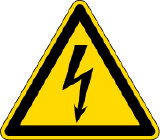 |
 |
Avoid shock hazard. If you see either of these symbols, there is a risk of electrical shock in the vicinity. Only qualified persons shall perform the related procedures. |
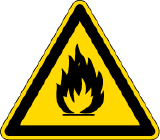 |
Avoid fire hazard. Do not test flammable or explosive samples. Read and follow the associated instructions carefully. | |
| Avoid toxic inhalation. Materials such as hydrochloric acid, hydrofluoric acid, and phosgene are highly toxic. If you plan to regularly use solvents containing halogenated hydrocarbons, be sure your work area is properly ventilated. | ||
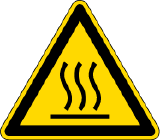 |
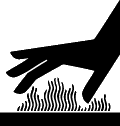 |
Avoid burn injury. These symbols alert you to hot surfaces. Read and follow the associated instructions carefully. |
 |
Avoid explosion hazard. These symbols alert you to the risk of a possible explosion. Never use a flammable, combustible, or toxic gas to purge this instrument. Heat from the source, or from laser absorption, may ignite flammable gases or reactive materials in purge gas. | |
 |
 |
Avoid eye injury. If you see these symbols, there is a risk of exposure to laser radiation in the vicinity. Read and follow the associated instructions carefully. |
| Avoid pinch hazard. If you see this symbol, there is a risk of pinch, crush, or impact hazards in the vicinity. | ||
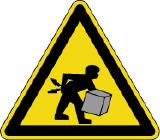 |
 |
Avoid risk of personal injury. If you see either of these symbols, use proper lifting techniques when moving the spectrometer or other system components. |
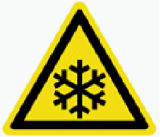 |
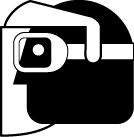  |
Avoid freeze burns. If you see any of these symbols, there is a risk of skin burns or eye damage. Protective equipment required. Follow standard laboratory safety practices. |
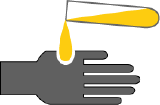 |
Avoid chemical burns. This symbol alerts you to possible skin irritation. Wear gloves when handling toxic, carcinogenic, mutagenic, corrosive, or irritant chemicals. Use approved containers and proper procedures to dispose of waste. |
Electrical symbols
| Symbol | Description |
 |
Alternating current |
 |
Earth terminal or ground |
 |
Direct current |
 |
Protective conductor terminal |
 |
Frame or chassis terminal |
 |
Fuse |
 |
Power on |
 |
Power off |
 |
Avoid personal injury. If this equipment is used in a manner not specified in the accompanying documentation, the protection provided by the equipment may be impaired. Avoid personal injury. Perform only those procedures described in the documentation. If there are other problems, contact us. Any other service must be performed by trained personnel. Avoid personal injury. Do not remove the cover of the instrument. All service to the instrument must be performed by trained personnel. |
For Research Use Only. This instrument or accessory is not a medical device and is not intended to be used for the prevention, diagnosis, treatment, or cure of disease.
Ingress protection rating
This product is rated IP20.
When the instrument arrives
- Check the exterior of the shipping box for signs of damage. If damage is apparent, contact us or your local distributor for instructions.
- Move the shipping box to the installation location at least 24 hours before installation.
- Keep the instrument upright while moving it to the installation location.
| The instrument is sealed in a plastic bag inside the shipping box to keep the unit dry. Allow 24 hours for the instrument to reach room temperature before opening the bag. If the bag is opened before the instrument reaches room temperature, moisture could condense on the optical components and cause permanent damage. |
It is important to have all system utilities installed before the spectrometer arrives. Utility installations must also comply with all local building and safety codes.
Lifting or moving the instrument
To avoid risk of injury, use proper lifting techniques when lifting or moving the instrument or other system components.
Lifting or moving this instrument requires two people. Be sure to grasp with both hands under the base on both sides of the instrument.
Specifications and workspace considerations
- Instrument weight: 70 lbs (32 kg)
- Dimensions: 57.15 cm (L), 54.6 cm (W), 31.75 cm (H)
If the optional sample compartment expansion kit is installed, the length (L) is increased by approximately 5 cm.
- Computer: Plan for location of the computer, monitor and keyboard.
A standard USB A-B data cable is required to connect the instrument to the computer.
- Clearance: Leave ample space near and behind the system to allow access to cable and purge connections. The presence of an additional space next to the instrument makes it easier to access, speeding up and facilitating maintenance and operation.
|
Do not position the instrument so that it is difficult to reach the cable connections and power switch. Use a heavy-duty table strong enough to support the weight of the instrument and any other items that you plan to place on the table. The table must not visibly flex or otherwise deform when the instrument is placed on it. A flat and stable tabletop is essential to maintain proper alignment of components and the beam path. Maintaining proper alignment is necessary for instrument stability. For more details, see Vibration. |
Electrical service specification
Input current: 2.5 A (max)
Input voltage: 100 to 240 VAC
Line frequency: 50 to 60 Hz
Line disturbance: Sags, surges, or other line disturbances must not exceed 10% of input voltage (even for a half cycle)
Noise: Less than 2 V common mode and less than 20 V (normal mode)
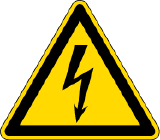 |
Avoid shock hazard. Each wall outlet used must be equipped with a ground. The ground must be a noncurrent-carrying wire connected to earth ground at the main distribution box. |
Temperature and humidity
- The instrument is designed for indoor use in normal operating environments (Pollution Degree 2).
- The instrument operates reliably at temperatures between 15 °C and 30 °C. For optimal performance, keep the temperature between 20 °C and 22 °C.
- Maintain humidity at 20% to 80%, non-condensing.
—When storing or operating the instrument in ambient conditions above 40% RH, it is highly recommended that the instrument be purged with dry air or nitrogen to protect the internal components
—Operation or storage with desiccant only in a high humidity environment may require desiccant replacement every 14 days depending on the conditions
—Do not rely on the humidity indicator to determine when the desiccant has become saturated; use the System Status table in OMNIC Paradigm software instead
- Avoid damage to the optical components
—Do not place system near sources of air conditioning ducts or large windows
—Do not place system near sources of heat, such as heating ducts, hot plates, or heating mantles
- Purge the system with clean dry air or nitrogen.
- Avoid rapid changes in temperature that may cause condensation.
Storage
When stored in the original shipping container, the instrument can be exposed to temperatures from -20 °C to 60°C without damage to the instrument. Maximum humidity for storage is 85% RH, non-condensing. The storage time for the instrument at high humidity in its original packaging ranges between 60 and 70 days. Storage at lower ambient humidity will extend this time.
Vibration
- The instrument will perform better in a mechanically stable environment.
- Keep instrument away from machinery that may vibrate the floor.
- Minimize or eliminate acoustic noise and vibration wherever possible.
- Consider placing instrument on a marble top table or counter.
Magnetic and electric fields
- Place instrument at least 5.5 m (18 ft) away from magnetic fields.
- Minimize or eliminate exposure to magnetic fields wherever possible.
- Some wireless devices may also affect instrument performance. If this type of interference is suspected, move all wireless devices at least 2.0 m (6.5 ft) away from the instrument.

